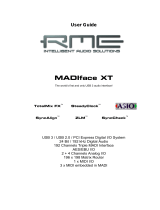If several digital devices are to be used simultaneously in a system, they not only have to
operate with the same sample frequency but also be synchronous with each other. This is why
digital systems always need a single device defined as ‘master’, which sends the same clock
signal to all the other (‘slave’) devices. RME’s exclusive SyncCheck technology enables an
easy to use check and display of the current clock status. The ‘SyncCheck’ field indicates
whether no signal (‘No Lock’), a valid signal (‘Lock’) or a valid and synchronous signal (‘Sync’)
is present at each of the digital clock source inputs. The ‘AutoSync Ref’ display shows the
current sync source and the measured frequency.
In practice, SyncCheck provides the user with an easy way of checking whether all digital
devices connected to the system are properly configured. With SyncCheck, finally anyone can
master this common source of error, previously one of the most complex issues in the digital
studio world.
Due to the HDSP 9632's outstanding clock control a synchronization of the output signal to the
input signal is not only possible at identical sample rates, but also at half, quarter, double and
quad sample rates. A playback of 192 kHz can be easily synchronized via a 48 kHz clock
source.
Thanks to its AutoSync technique and lightning fast PLLs, the Hammerfall DSP is not only
capable of handling standard frequencies, but also any sample rate between 25 and 200 kHz.
Even the word clock input, which most users will use in varispeed operation, allows any
frequency between 25 kHz and 200 kHz.
At 88.2 or 96 kHz: If the ADAT input has been selected in ‘Pref Sync Ref’, the sample
frequency shown in the ‘SPDIF In’ field differs from the one shown in ‘AutoSync Ref’. The card
automatically switches to its Sample Split mode here, because ADAT optical inputs and outputs
are only specified up to 48 kHz. Data from/to a single input/output is spread over two channels,
the internal frequency stays at 44.1 or 48 kHz. In such cases, the ADAT sample frequency is
only half the SPDIF frequency.
10. Word Clock
10.1 Technical Description and Usage
Correct interpretation of digital audio data is dependent upon a definite sample frequency.
Digital signals can only be processed or transferred between devices if these share the same
clock. Otherwise the signals are misinterpreted, causing distortion, clicks/crackle or dropouts.
AES/EBU, SPDIF and ADAT are self-clocking, so an additional line for word clock could be
considered redundant. In practice however, using several devices at the same time can cause
problems. For example, if devices are connected in a loop without there being a defined
‘master’ device, self-clocking may break down. Besides, the clocks of all devices must be
synchronized from a single source. Devices without SPDIF inputs (typically playback devices
such as CD players) cannot be synchronized via self-clocking.
In digital studios, synchronization requirements can be met by connecting all devices to a
central sync source. For instance, the master device could be a mixing desk, sending a
reference signal - word clock - to all other devices. However, this will only work if all the other
devices have word clock inputs (e.g. some professional CD players) allowing them to run as
slaves. This being the case, all devices will receive the same clock signal, so there is no
fundamental reason for sync problems when they are connected together.
But word clock also has some disadvantages. The word clock is based on a fraction of the
actually needed clock. For example SPDIF: 44.1 kHz word clock (a simple square wave signal)
has to be multiplied by 256 inside the device using a special PLL (to about 11.2 MHz). This
signal then replaces the one from the quartz crystal. Big disadvantage: because of the high
multiplication factor the reconstructed clock will have great deviations called jitter. The jitter of
a word clock is typically 15 times higher as when using a quartz based clock.



























